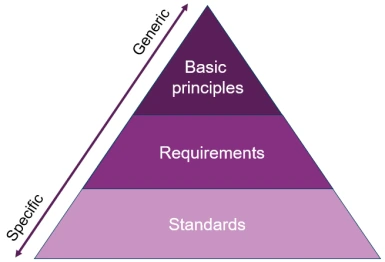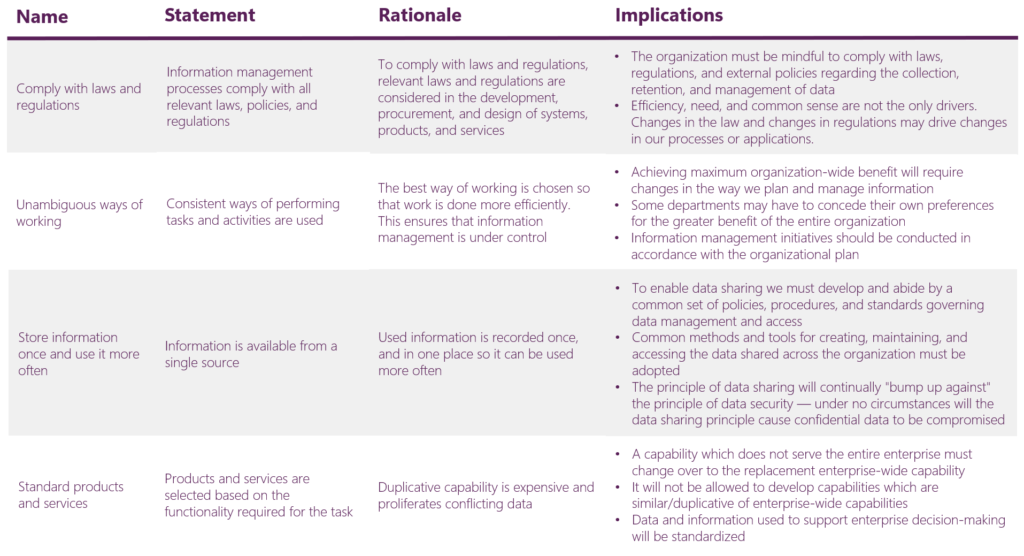A Principles Catalog contains basic principles, which are guidelines. Basic principles are similar to the constitution of a country. They have a high level of abstraction and serve as a kind of guiding light that can be used to give further direction and interpretation to their application and use. Basic principles are highly influential and strategic in nature. They are carefully designed to fit the organization and its business model. Like a constitution, these principles change little or nothing and have a strong binding character. The high-level or basic principles are based on business goals and objectives1.
Framework Pyramid
The structure of the principles, requirements, and standards can be visualized using a Framework Pyramid. At the top of the pyramid are the basic principles. The middle layer represents the requirements, and the base of the pyramid represents the standards.

An initial insight provided by a Framework Pyramid relates to the numbers to be used for the framework concepts. For example, in the figure, it is easy to see that the top of the pyramid is relatively small. This is a direct reflection of the recommended number of basic principles. In this case, less is more.
The layer below, that of requirements, is already somewhat wider, indicating that there can be more requirements than basic principles. The bottom layer, where the standards are, is the broadest layer. This means that there are (or can be) more standards than basic principles and requirements.
A second insight is that reading from top to bottom, the degree of specificity increases as you go down. A requirement is more detailed than a principle, and a standard is much more specific than a requirement.
Detailing the differences

Aside from the fact that requirements are more detailed than principles, there is another difference between the two concepts. Principles are directive (and therefore not mandatory), while requirements can be seen as prescriptive (and indeed mandatory). The wording of the concepts also plays an important role. This is the distinction between generic properties and specific properties. Thus, a principle states a property without detail and at a high level (generic). A requirement makes this generic property specific. For example, a principle might state that laws and regulations must be followed. The principle does not specify which laws and regulations apply. A requirement does. Finally, a standard is simply the result of a broad specification of a requirement. Standards are comparable to Solution Building Blocks in the TOGAF Standard.
Basic principles
It is important to realize that basic principles are similar to assumptions that are made about general descriptions of how a system works. The word principle comes from the Latin word principium, which means beginning and foundation. Here you can clearly see the relationship to what ISO/IEC/IEEE 420102 indicates in its definition of a architecture.
The fundamental concepts or properties of an entity in its environment and governing principles for the realization and evolution of this entity and its related life cycle processes.3
Enterprise Architecture principles often give meaning to the core parameters of the whole. E.g., they give meaning to the extent to which systems are sourced, the degree of integration, centralization, and specialization of systems, and the degree of innovation the organization intends to pursue.
The TOGAF Standard defines principles as follows.
Principles are general rules and guidelines, intended to be enduring and seldom amended, that inform and support the way in which an organization sets about fulfilling its mission4.
Applying the method
Basic principles form the top of the Framework Pyramid. This means that there should not be hundreds of principles. An average of four or five is more than sufficient. The key is to work toward the suggested number. If, despite your best efforts, more than the suggested four or five basic principles have been developed, it is still advisable to take another look at the framework that has been established. If possible, try to combine or simplify topics so that the suggested four or five principles remain.
The reason for keeping the number of principles small has to do with the ramifications from principle to requirement and from requirement to standard. Assuming that each basic principle can easily have three requirements, and that each requirement may have about five standards, this results in sixty (4·3·5=60) standards with four basic principles. If six basic principles are developed, then with the same number of requirements and standards, this can easily result in a total of ninety (6·3·5=90) standards.
Gathering information
To arrive at a set of basic principles, it is important to look at the organization as a whole. By asking a few simple questions, it should be possible to get to the heart of what is important to the organization:
- What is the organization on earth for?
- What does the organization really want to accomplish?
- What drives the organization to do what it does every day?
- What is most important to the organization (what processes and applications)?
- What internal and external factors impact the organization?
In fact, these are pretty much the same questions that can be asked to arrive at goals and their associated objectives. The questions (and answers) can also be used to establish basic principles.
Representation
A basic principle always consists of the following components.
- Name. The name of the principle represents its essence. Choose a name that is easy to remember and avoid including details. For example, never refer to specific technologies, platforms, products, or specific laws and regulations. Avoid ambiguous words.
- Statement. Provide a clear (short) statement or explanation of the principle. Summarize the meaning in one sentence.
- Rationale. The rationale presents the benefits of applying the principle. It uses the language of the organization.
- Implications. Implications indicate what is needed to implement or be able to apply the basic principle. For example, consider the resources or costs required. The impact of applying the principle needs to be made clear.

Four basic principles
In many cases, an organization depends on a few essential things to achieve its goals. These include the delivery of products and/or services, the delivery of products and/or services according to a consistent way of working, the efficient use of information, and compliance with applicable laws and regulations.
The above essentials can be easily translated into the following four basic principles.
- Comply with laws and regulations. To comply with laws and regulations, relevant laws and regulations are considered in the development, procurement, and design of systems, products, and services.
- Unambiguous ways of working. Consistent ways of performing tasks and activities are used. The best way of working is chosen so that work is done more efficiently. This ensures that information management is under control.
- Store information once and use it more often. Used information is recorded once and in one place so it can be used more often. Information is available from a single source.
- Standard products and services. Off-the-shelf applications and IT systems are used as much as possible. Products and services are selected based on the functionality required for the task.
Of course, not every organization is the same. Therefore, not all of the above principles can be applied without modification. For this reason, the above set of four basic principles is intended as an illustration or starting point.
More information
For additional information about creating a Principles Catalog, please refer to Chapter 8, Sections 8.3.2.1 through 8.3.2.4, of my book Getting Started with Enterprise Architecture.
Back to
- J. Ziemann, Fundamentals of Enterprise Architecture Management. Cham: Springer Nature, 2022. ↩︎
- ISO (International Organization for Standardization), “Systems and software engineering — Architecture description”, https://www.iso.org/standard/74393.html, 2022. ↩︎
- ISO (International Organization for Standardization), “Systems and software engineering — Architecture description”, https://www.iso.org/standard/74393.html, 2022. ↩︎
- The Open Group, The TOGAF® Standard, 10th Edition, Content, Capability, and Governance. ’s-Hertogenbosch: Van Haren Publishing, 2022. ↩︎
